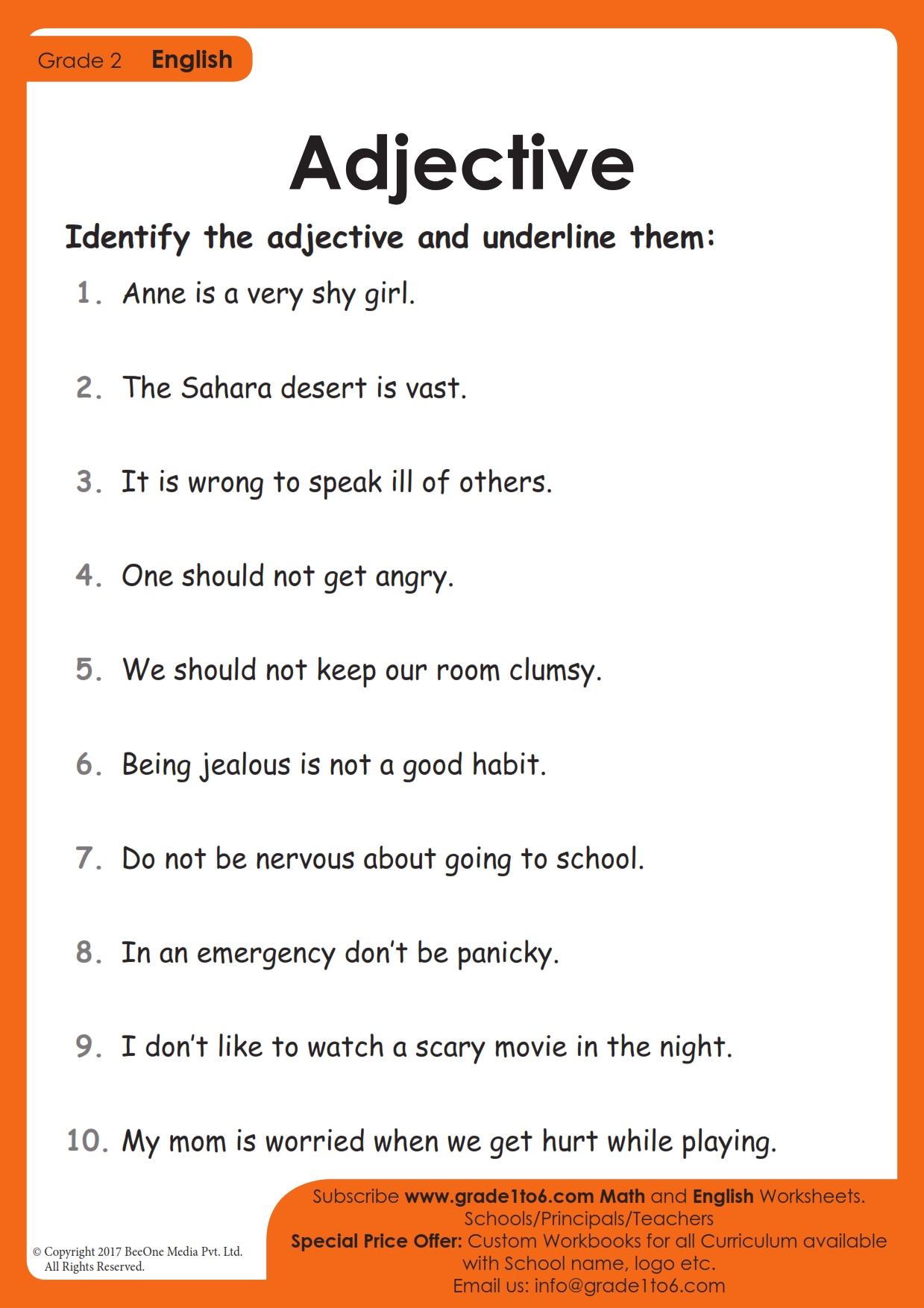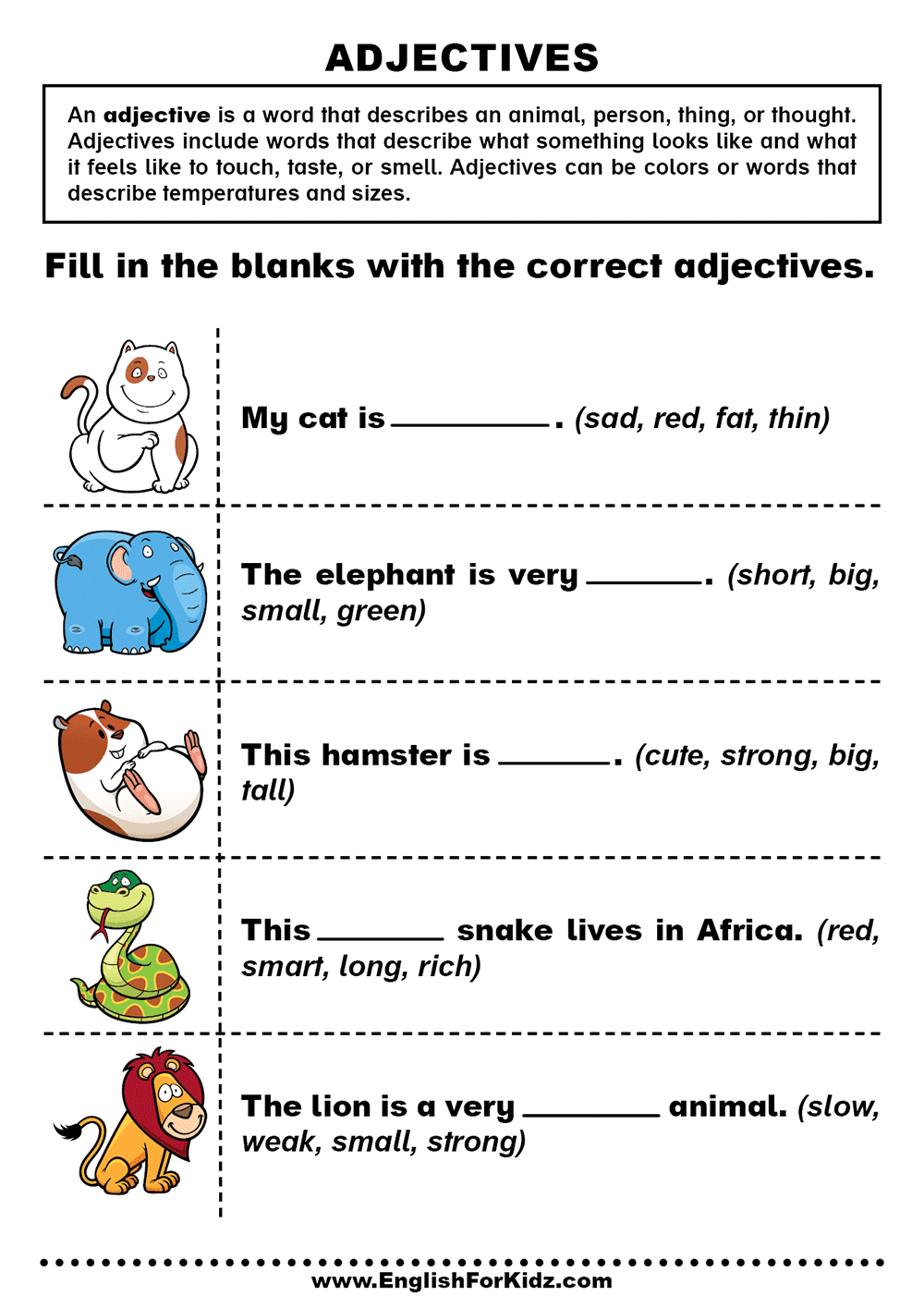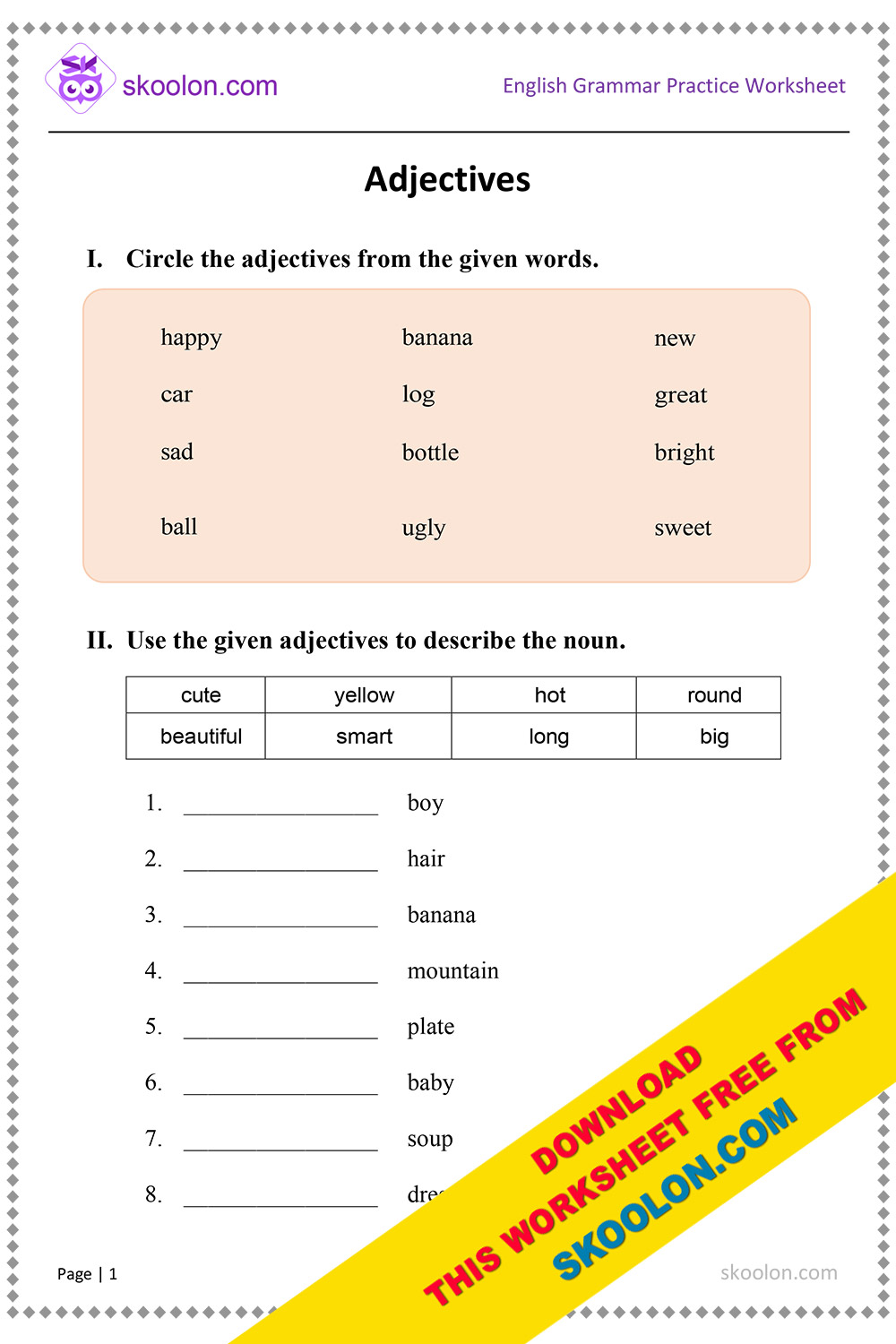
The Colorful World of Words: Unlocking Language with Adjectives Worksheets for Grade 1
Adjectives are the vibrant colors in the paintbox of language, adding depth, detail, and emotion to our descriptions. They transform plain nouns into vivid images, allowing us to describe a "red, shiny apple" instead of just an "apple," or a "fluffy, white cloud" instead of just a "cloud." For first-grade students, grasping the concept of adjectives is a foundational step in developing rich, descriptive language skills, both in speaking and writing. This is where adjectives worksheets for grade 1 become an invaluable resource, providing structured, engaging, and age-appropriate tools to introduce, practice, and reinforce this crucial grammatical concept.
At this early stage of development, children are rapidly expanding their vocabulary and beginning to construct more complex sentences. Learning about adjectives empowers them to move beyond simple statements and express themselves with greater precision and creativity. This comprehensive article will explore the significance of teaching adjectives in the first grade, the multifaceted benefits of utilizing worksheets, effective design principles for these resources, and practical strategies for integrating them into a holistic language arts curriculum.
The Crucial Role of Adjectives in Grade 1 Language Development

Why is it so important to focus on adjectives for first graders? Several key reasons highlight their significance:

- Enhancing Descriptive Language: Adjectives are the building blocks of descriptive writing and speaking. By understanding how to use words like "big," "small," "happy," or "sad," children can paint clearer pictures with their words, making their communication more engaging and understandable.
- Improving Reading Comprehension: When reading stories, adjectives provide vital clues about characters, settings, and objects. A child who understands "scary monster" or "beautiful princess" gains a richer comprehension of the narrative than one who only processes "monster" or "princess."
- Vocabulary Expansion: Learning adjectives naturally expands a child’s active vocabulary. They learn synonyms and antonyms (e.g., "hot" and "cold," "big" and "tiny"), which enriches their linguistic repertoire.
- Connecting to Sensory Experiences: Many adjectives directly relate to the five senses (e.g., "soft," "loud," "sweet," "bright," "smooth"). Teaching adjectives helps children articulate their sensory observations, fostering a deeper connection with the world around them.
- Building Blocks for Future Grammar: A solid understanding of adjectives lays the groundwork for more complex grammatical concepts later on, such as adverbs, comparative and superlative forms, and richer sentence structures.



Why Opt for Adjectives Worksheets for Grade 1? The Multifaceted Benefits

While various teaching methods exist, adjectives worksheets for grade 1 offer unique advantages that make them particularly effective for young learners:
- Structured Learning: Worksheets provide a clear, step-by-step approach to learning. They can introduce concepts gradually, starting with identification and moving towards application, ensuring a logical progression of skills.
- Reinforcement and Practice: Repetition is key for mastery, especially in early learning. Worksheets offer ample opportunities for children to practice identifying, using, and even generating adjectives, solidifying their understanding.
- Visual Learning Support: First graders are highly visual learners. Well-designed worksheets incorporate engaging illustrations, colors, and clear layouts that make abstract concepts more concrete and appealing.
- Engagement and Fun: When designed creatively, worksheets can be far from tedious. Incorporating themes (animals, food, seasons), puzzles, coloring activities, or simple games can transform learning into an enjoyable experience.
- Assessment and Feedback: Worksheets serve as a valuable tool for teachers and parents to assess a child’s understanding. Errors can highlight areas needing more attention, allowing for targeted feedback and intervention.
- Independent Practice: Worksheets can be completed independently, fostering self-reliance and allowing children to work at their own pace. This is particularly useful in a classroom setting where teachers need to manage multiple students.
- Variety of Activities: A good set of worksheets will offer diverse activities, preventing boredom and catering to different learning styles. From circling adjectives to filling in the blanks or matching, variety keeps students engaged.



By leveraging effective adjectives worksheets for grade 1, educators and parents can provide a structured, supportive, and stimulating environment for young learners to master this essential linguistic concept.
Designing Engaging and Effective Adjectives Worksheets for Grade 1
The effectiveness of adjectives worksheets for grade 1 hinges significantly on their design. Here are key principles to consider when creating or selecting these resources:
-
Age-Appropriate Content and Layout:
- Large, Clear Font: Easy to read for developing readers.
- Ample White Space: Prevents visual clutter and overwhelming the child.
- Simple Instructions: Use clear, concise language and perhaps a visual example. "Circle the word that tells about the dog."
- Relatable Themes: Use pictures and examples of things first graders know and love: animals, toys, food, nature, friends, family.
-
Visual Appeal:
- Bright Colors: Use a vibrant palette to make the worksheet attractive.
- Engaging Illustrations: High-quality, clear, and relevant pictures are crucial. They aid comprehension and make the worksheet fun. For instance, a worksheet asking to describe a monster should have a friendly, cartoonish monster illustration.
- Fun Graphics: Incorporate elements like stars, happy faces, or thematic borders.
-
Variety of Activity Types: To keep children engaged and reinforce learning from different angles, include a mix of the following:
- Identifying Adjectives:
- Circling/Underlining: Given a sentence, circle the word that describes a noun.
- Coloring: Color all the adjectives in a word list or a short paragraph.
- "Find the Adjective" in a Picture: Provide a picture and a list of words; students identify which words describe the picture.
- Matching Activities:
- Word to Picture: Match an adjective (e.g., "tall") to a corresponding picture (e.g., a tall tree).
- Adjective to Noun: Match an adjective to a noun it can describe (e.g., "fluffy" to "cat," "sweet" to "candy").
- Opposites (Antonyms): Match adjectives to their opposites (e.g., "hot" to "cold," "big" to "small").
- Filling in the Blanks:
- Choose from a Word Bank: Provide a sentence with a blank and a small word bank of adjectives for students to choose from. "The __ flower is pretty." (Options: red, run, on)
- Student’s Choice: Allow students to write their own adjective to complete a sentence, encouraging creativity.
- Describing Pictures:
- List Adjectives: Show a picture (e.g., a sunny beach) and ask students to write 3-5 adjectives that describe it.
- Sentence Construction: Provide a picture and a simple noun, then ask students to write a sentence using an adjective to describe that noun. "The __ cat." (Students write: "The sleepy cat.")
- Sorting Activities:
- Adjective vs. Non-Adjective: Given a list of words, students sort them into "Adjective" and "Not an Adjective" columns.
- Categorizing Adjectives: Sort adjectives by what they describe (e.g., color, size, feeling).
- Simple Creative Writing Prompts:
- "Describe your favorite animal using three adjectives."
- "If you were a superhero, what three adjectives would describe your powers?"
- Identifying Adjectives:
-
Scaffolding and Progression: Start with very simple tasks (e.g., identifying obvious color adjectives) and gradually introduce more nuanced adjectives or more complex sentence structures. Provide examples for each new activity type.
-
Clear Learning Objectives: Each worksheet should have a clear purpose. Is it for identification? Application? Vocabulary building? This helps in selecting the right activity and assessing its effectiveness.
Integrating Adjectives Worksheets for Grade 1 into the Curriculum
Worksheets are most effective when they are part of a larger, integrated approach to teaching language arts. Here’s how to seamlessly incorporate adjectives worksheets for grade 1 into the learning process:
- Pre-teaching and Introduction: Before diving into worksheets, introduce adjectives through interactive activities. Use real objects in the classroom (e.g., "This is a soft teddy bear," "This is a red apple"). Read aloud books rich in descriptive language and point out adjectives as you read. Play "I Spy" using adjectives ("I spy something blue and round").
- Guided Practice: Use worksheets as a guided activity during lessons. Work through the first few problems together as a class or in small groups. This allows students to ask questions and receive immediate feedback.
- Independent Practice and Reinforcement: Once students understand the concept, assign worksheets for independent practice in class or as homework. This reinforces what they’ve learned and builds confidence.
- Differentiation: Not all students learn at the same pace. Have a range of worksheets, from simpler ones with fewer choices or more visual cues, to more challenging ones that require more independent thought or sentence construction.
- Cross-Curricular Connections: Integrate adjectives into other subjects.
- Science: Describe plants, animals, or weather using adjectives.
- Art: Describe colors, shapes, and textures in artworks.
- Social Studies: Describe historical figures or places.
- Post-Activity Discussion: After completing a worksheet, discuss the answers as a class. Ask students to explain why a certain word is an adjective or to use it in a new sentence. This promotes deeper understanding and critical thinking.
Beyond the Worksheet: Holistic Approach to Learning Adjectives
While adjectives worksheets for grade 1 are powerful tools, they are just one component of a comprehensive language arts program. To truly solidify a child’s understanding and application of adjectives, consider these complementary strategies:
- Interactive Games: Play "Adjective Charades" (act out an adjective like "sleepy" or "hungry"), "Adjective Bingo," or descriptive scavenger hunts.
- Read-Alouds and Discussions: Continuously read books that feature strong descriptive language. After reading, discuss the adjectives used: "What words did the author use to describe the giant?"
- Real-World Application: Encourage students to use adjectives in their daily conversations. Ask them to describe their day, their favorite food, or a new toy using descriptive words.
- "Show, Don’t Tell" Activities: Encourage them to use adjectives to "show" what they mean instead of just telling. For example, instead of "He was sad," prompt them to say "He had a droopy face and tearful eyes."
- Adjective Walls/Charts: Create a classroom chart or "adjective wall" where students can contribute new adjectives they learn or find in books. Organize them by categories (colors, sizes, feelings, textures).
Common Challenges and Solutions
Even with well-designed worksheets, some challenges might arise:
- Challenge: Students confuse adjectives with other parts of speech (e.g., verbs or nouns).
- Solution: Focus on the "what kind?" or "how many?" questions adjectives answer. Provide explicit examples of words that aren’t adjectives. Use sorting activities where they categorize words.
- Challenge: Limited vocabulary for describing.
- Solution: Provide word banks. Introduce new adjectives through stories and direct instruction. Use picture dictionaries to expand their descriptive word choices.
- Challenge: Boredom or lack of engagement.
- Solution: Vary the types of worksheets. Incorporate games and hands-on activities before or after worksheet completion. Make the content highly relevant to their interests.
- Challenge: Overwhelm with too much text or too many tasks.
- Solution: Break down worksheets into smaller, manageable sections. Use fewer problems per page. Ensure instructions are incredibly simple and clear, possibly with a visual example for each task.
Tips for Parents and Educators
- Be Patient and Positive: Learning grammar takes time. Celebrate effort and small victories.
- Make it Fun: Incorporate play, humor, and creativity into the learning process.
- Model Descriptive Language: Use adjectives frequently in your own speech. "What a beautiful drawing!" "That’s a delicious dinner!"
- Observe and Adapt: Pay attention to which activities resonate with your child/students and which concepts they struggle with. Adjust your approach accordingly.
- Connect to Interests: If a child loves dinosaurs, find worksheets or books that allow them to describe fierce dinosaurs or enormous fossils.
Conclusion
The journey of language acquisition in first grade is a thrilling adventure, and mastering adjectives is a significant milestone along the way. Adjectives worksheets for grade 1 are indispensable tools in this journey, offering a structured, engaging, and effective means to introduce, practice, and solidify this fundamental grammatical concept. By utilizing well-designed worksheets in conjunction with interactive activities, real-world applications, and a supportive learning environment, educators and parents can empower young learners to become confident communicators, capable of painting vibrant, descriptive pictures with their words. Ultimately, well-designed adjectives worksheets for grade 1 are more than just exercises; they are gateways to a richer, more expressive, and more colorful understanding of the English language.
